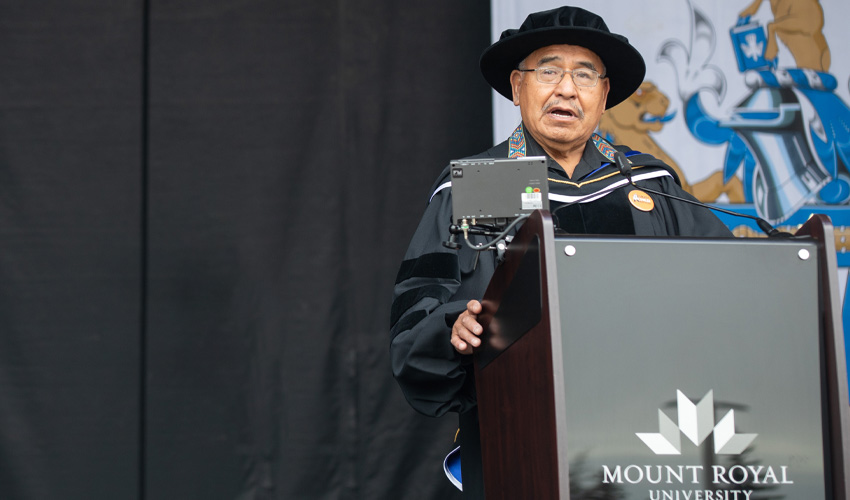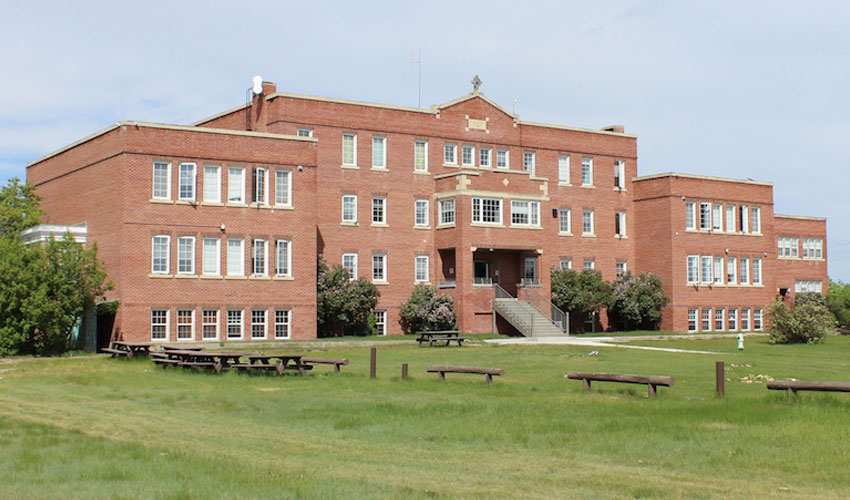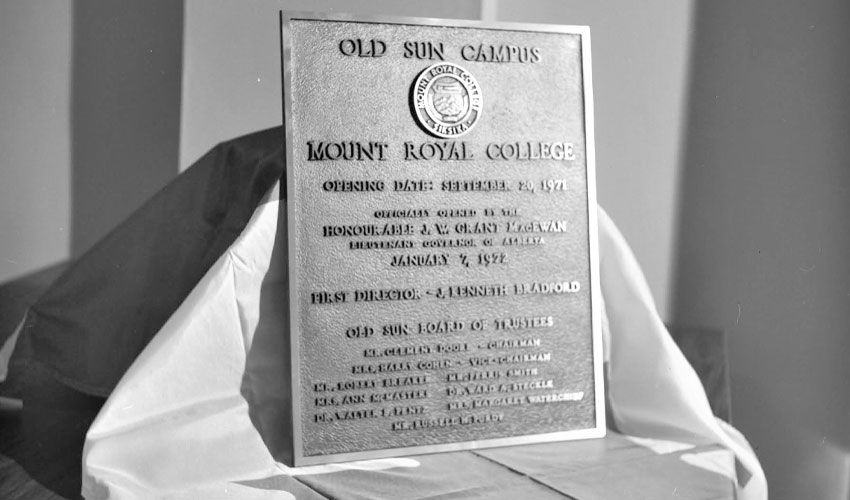From darkness to light: Old Sun Community College marks 50th anniversary
College began as a satellite campus of Mount Royal

Clarence Wolfleg Senior (Elder Miiksika’am), residential school survivor, spiritual elder adviser to national, provincial and local organizations, including MRU.
At age six, Mount Royal University spiritual advisor Elder Miiksika’am was sent to Old Sun Residential School on the Siksika Nation east of Calgary.
Living in “That place,” as he refers to it, was a grim and dispiriting time for the elder, who was renamed to Clarence Wolfleg (renaming was done to thousands of Indigenous children who endured the so-called schools). Many did not make it out alive and those who did often returned to families shattered by forced separation and over a hundred years of attempted assimilation.
Miiksika’am told friends one night: “‘You know what I’m going to be when I get out of this place? I’m going to be a soldier like my father (who served Canada in the Second World War), and when I come back, I’m going to be a leader of my people.’ When I was at ‘that place,’ I believe my destiny was set.”
Miiksika’am, whose name means “Red Crane,” would achieve both goals, participating in UN peacekeeping initiatives in Cypress, in NATO European missions during the Cold War and filling many roles serving his community, ranging from a special constable and police chief to leading outpatient community programs for Siksika Alcohol Services, working as a case management officer for Correctional Services of Canada and taking on the role of communications officer at the Old Sun Community College.
Recalling his memories of the school as he received an Honorary Doctor of Laws from MRU in June, Miiksika’am said the “happiest moment I had was when I left there and … I wasn’t going back. I looked back and said, ‘Well, you didn’t get the best of me. I’m still alive. My spirit is still with me.”
This month, as MRU engages in its Journey to Indigenization leading up to and following the National Day for Truth and Reconciliation on Sept. 30, Old Sun Community College marks its 50th anniversary as a post-secondary institution and its transformation to a place of learning and positive change.
50 years of new life
The original Old Sun Boarding School opened in 1886 and was renamed after Na’to’sapi, or “Old Sun,” a revered Niitsitapi leader. Rebuilt after a fire in 1929, it was run as a residential school by the Anglican Church and the federal government, taking part in cultural genocide that sought to rid Indigenous children of their culture and separate them from their families and their land to facilitate colonization and assimilation.
While the school’s history casts a dark, destructive shadow, it has enjoyed a second life as a source of hope and learning. Leaders of the Siksika Nation in the 1970s took control of the Old Sun Residential School building and transformed it into the Old Sun Community College for Niitsitapi (Blackfoot) students.

Leaders of the Siksika Nation in the 1970s took control of the Old Sun Residential School building and transformed it into the Old Sun Community College for Niitsitapi (Blackfoot) students.
MRU student Wacey Little Light, a member of Siksika Nation, and historian Dr. Sean Carleton, PhD, (formerly of MRU and now at the University of Manitoba) published a research note in Prairie History (4, Winter 2021) entitled, “Old Sun, New Buffalo: A Siksika School’s Transformation from Residential School to Community College.”
Their work drew in part, on information found in MRU’s Archives and Special Collections, to support the new Old Sun college when its doors opened Sept. 20,1971. An official opening ceremony in January of 1972 involved the whole community, as well as provincial officials such as Leut. Gov. Grant MacEwan. Siksika Chief Leo Pretty Young Man lauded the interest in post-secondary education for his people.
“Our people are making progress in many fields,” he said. “We are beginning to manage our own affairs and attempting to solve our own problems.”
Old Sun was one of the first “partnership” colleges in Canada and began as a satellite campus of what was then Mount Royal College (MRC) and was jointly administered by the Siksika Nation, MRC and the Department of Indian Affairs with additional support from the Government of Alberta.
Currently, Old Sun is a First Nation, board-governed college operating as a comprehensive and non-profit community institution offering broad programming including certificates, diplomas, foundational learning and upgrading. Programs are learner-centred, outcome-focused and designed to provide graduates with opportunities to improve their quality of life, prepare for further education and advance their careers. There is also an emphasis on information technology, Siksika knowledge studies and foundational learning.

An official opening ceremony in January of 1972 involved the whole community, as well as provincial officials such as Leut. Gov. Grant MacEwan.
A one-time residential student and now a teacher at Old Sun, Vivian Ayoungman works to preserve the culture of her people and pass it on.
"We've been undoing what this place tried to do to us when operating as a residential school. We've been teaching our language, we're reconnecting our students,” she said during a tour of the school on graduation day this summer, featured on CBC Radio program The Current.
She recalled a game of tag when she called out a playful warning to a cousin, in Blackfoot. A supervisor stopped the game immediately and Ayoungman received the strap.
When she received the strap the group was warned: 'This is what happens to you when you speak your language.” Years later when she told the story to a group of her adult students, they clapped and cheered, telling her: “They didn’t beat (your language) out of you” as they thanked her for teaching it to them.
The new buffalo
Little Light and Carleton note: “Indigenous Peoples on the prairies often say that education, and specifically post-secondary schooling is “the new buffalo.” Like buffalo hunts of previous generations, obtaining an education is now seen as a way of sustaining Indigenous lifeways and passing on Indigenous knowledge to new generations.”
An installation called inni awatto (Buffalo on the Move) on the MRU campus, located on the west side of Charlton Pond near Recreation, promotes the same stirring message. As part of iinistsi 141, a day of marking the anniversary of the signing of Treaty 7, the installation, which includes signage and carefully placed rocks, officially opened on Sept. 21, 2018.
MRU and the Social Sciences and Research Council of Canada supported the research. Carleton said that when he started as a professor at MRU in 2016, Little Light told him about the school’s connection to Mount Royal.
“As a historian of residential schooling, I wanted to learn more, and Wacey was interested in getting to the bottom of the story, too,” Carleton says. “I really enjoyed working with Wacey on this project and hope that it can inspire staff and students at MRU to become more aware about its connection to Old Sun College.”
Read a timeline of Old Sun College’s history. The MRU Library has gathered a collection of resources on residential schools, available for the MRU community to request through their contactless pick up service or to read online.
Sept. 28, 2021 — Peter Glenn
Media request contact information.
Have a story idea? Please fill out this form.

